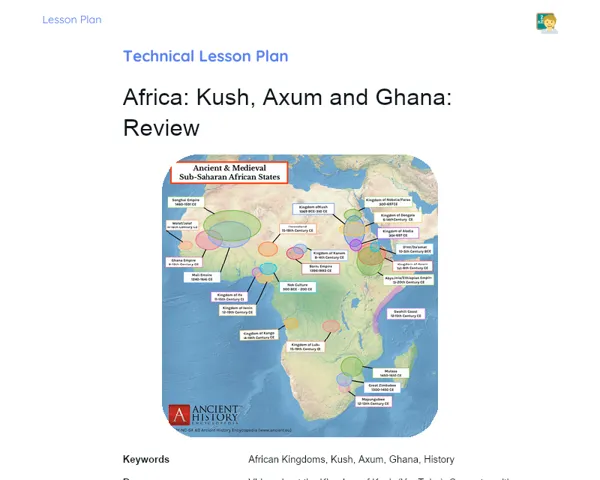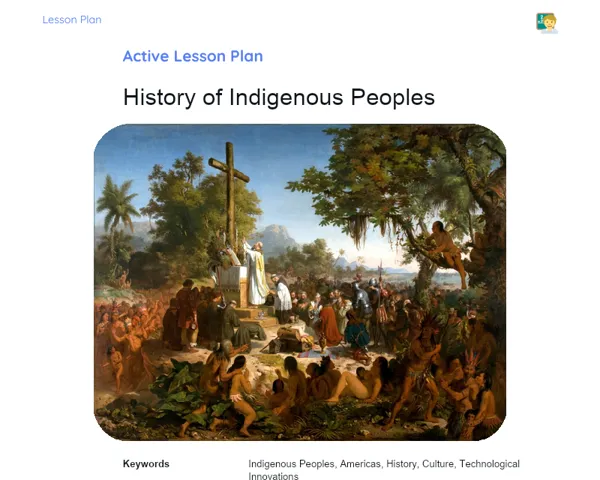Lesson Plan Teknis | Ancient Rome: Introduction
| Palavras Chave | Ancient Rome, History, Roman Law, Architecture, Latin Language, Roman Religion, Critical Thinking, Historical Reflection, Maker Activity, Job Market, Model, Teamwork, Planning, Urban Planning |
| Materiais Necessários | A brief video on the founding of Rome, Computer and projector for video display, Papers and pens for note-taking, Recyclable materials (cardboard, plastic bottles, popsicle sticks), Hot glue, Scissors, Ruler, Markers, Sketch paper, Whiteboard and markers |
Objective
Duration: (10 - 15 minutes)
The aim of this section is to lay a strong foundation on the history of Ancient Rome and its lasting contributions to the Western world. Grasping these elements is not only essential for understanding history but also for nurturing practical skills that are valued in the job market, such as critical thinking and the ability to draw cultural and historical connections.
Objective Utama:
1. Explore the history of Ancient Rome and its key characteristics.
2. Recognise Roman contributions to the Western world, including law, architecture, language, and religion.
Objective Sampingan:
- Examine Roman influence on modern culture.
- Enhance critical analysis and historical reflection skills.
Introduction
Duration: (10 - 15 minutes)
The purpose of this stage is to establish a solid groundwork on Ancient Rome's history and its significant contributions to the Western world. Understanding these facets is paramount not just for historical insight but also for honing practical skills that are highly sought after in the job market, such as analytical thinking and forming cultural and historical ties.
Curiosities and Market Connection
Curiosities: Rome is said to have been founded in 753 BC, according to legend, by the twin brothers Romulus and Remus, who were nurtured by a she-wolf. The Colosseum, one of the most renowned landmarks in Rome, had a seating capacity for about 50,000 spectators.
Market Connection: Law: The Roman legal system has had a tremendous influence on present-day legal frameworks. Legal professionals like attorneys and judges still learn about Roman Law. Architecture: Roman building techniques, including the arch and concrete usage, are taught and used by modern engineers and architects. Language: Latin, the language spoken by the Romans, forms the basis of many words in contemporary languages, particularly Romance languages. Translators and linguists frequently refer back to Latin.
Contextualization
Ancient Rome stands out as one of the most significant civilisations in history. From its legendary beginnings with Romulus and Remus to its development into a vast empire, Roman culture and advancements have left an enduring legacy. Iconic architecture, the legal system, and the proliferation of Latin are just a few of the contributions that have shaped our modern Western world. Comprehending Rome's past is crucial for understanding the foundations of many current institutions and practices.
Initial Activity
Short Video: Kick off the class with a quick, engaging video about the founding of Rome and its major milestones. (5 - 7 minutes) Provocative Question: Post-video, pose this question to the students: 'How do you think the world would look today without Rome's contributions?' Allow them to discuss in pairs for a few minutes before sharing their thoughts with the class. (3 - 5 minutes)
Development
Duration: (40 - 50 minutes)
The objective of this section is to deepen students' appreciation of Ancient Rome's historical significance through engaging and critical activities. By constructing a model and addressing analytical questions, learners reinforce their understanding while developing vital skills in critical thinking and practical application, both of which are crucial for the job market.
Topics
1. The founding of Rome and the legend of Romulus and Remus
2. Expansion and the Roman Empire
3. Roman contributions to legal systems
4. Roman architecture and its notable structures
5. The Latin language and its significance
6. Roman religion and myths
Thoughts on the Subject
Encourage students to think about how Roman culture and breakthroughs continue to affect their lives today. Ask them which facets of modern society they reckon would change if the Roman legacy didn’t exist. Prompt them to consider areas such as justice, engineering, language, and religion.
Mini Challenge
Constructing a Roman City
In this interactive activity, students will work together to build a model of a Roman city. Using recyclable and accessible materials like cardboard, plastic bottles, popsicle sticks, and hot glue, students should replicate key elements of Roman architecture, including the Colosseum, aqueducts, roads, and temples.
1. Split the students into groups of 4 to 5.
2. Give a brief rundown of the main Roman architectural features and their roles in the city.
3. Hand out the materials and tools needed to build the model.
4. Instruct students to plan and sketch their city before diving into construction.
5. Support the students during the building phase, promoting teamwork and division of tasks.
6. Once completed, ask each group to present their model and explain their design choices and the significance of the elements they highlighted.
The goal of this activity is for students to put into practice the knowledge they've gathered about Roman architecture and city planning in a collaborative and hands-on approach. Building the model fosters skills in planning, teamwork, and spatial awareness.
**Duration: (30 - 40 minutes)
Evaluation Exercises
1. Discuss how the Roman legal system has shaped contemporary legal frameworks, giving specific examples.
2. Outline Roman contributions to modern architecture. Which innovations are still in use today?
3. Identify words in Portuguese that derive from Latin. Discuss how Latin has influenced the evolution of Romance languages.
4. Compare ancient Roman religion with a contemporary faith. What are the similarities and differences?
Conclusion
Duration: (10 - 15 minutes)
The purpose of this final stage in the lesson plan is to cement learning by bridging theory with practice and stimulating critical thought regarding the historical and modern significance of Roman contributions. This wrap-up allows students to reflect on and internalize the knowledge gained while enhancing their analytical and reflective skills.
Discussion
Lead a discussion with the students about the key points covered throughout the lesson. Inquire how building the model aided their understanding of Roman city planning and architecture. Encourage them to reflect on how Roman contributions have permeated their daily lives and modern society. Talk about how practical activities and follow-up exercises enabled them to link theory with practice.
Summary
Summarise the main topics discussed, including the founding of Rome, its territorial expansion, and Roman contributions to law, architecture, language, and religion. Remind students of the significance of these aspects and their impact on the modern world.
Closing
Let the students know that today’s lesson not only provided insights into Ancient Rome but also fostered practical skills such as teamwork, planning, and critical thinking. Highlight the enduring relevance of Roman contributions, stressing that grasping these topics is vital for developing informed citizens and proficient professionals.


